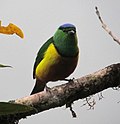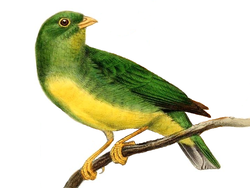| Image | Common name | Scientific name | Distribution |
|---|
 | Elegant euphonia | Chlorophonia elegantissima | Belize, Costa Rica, El Salvador, Guatemala, Honduras, Mexico, Nicaragua, and Panama. |
| Hispaniolan euphonia | Chlorophonia musica | Hispaniola (Dominican Republic and Haiti) |
 | Puerto Rican euphonia | Chlorophonia sclateri | Puerto Rico |
| Lesser Antillean euphonia | Chlorophonia flavifrons | Lesser Antilles |
 | Golden-rumped euphonia | Chlorophonia cyanocephala | Argentina, Bolivia, Brazil, Colombia, Ecuador, French Guiana, Guyana, Paraguay, Peru, Suriname, Trinidad and Tobago, and Venezuela. |
 | Blue-naped chlorophonia | Chlorophonia cyanea | south-eastern Brazil, eastern Paraguay and north-eastern Argentina, the Andes from Bolivia in south to Venezuela in north, the Perijá and Santa Marta Mountains, the Venezuelan Coastal Range, and the Tepuis. |
 | Chestnut-breasted chlorophonia | Chlorophonia pyrrhophrys | Colombia, Ecuador, Peru, and Venezuela. |
 | Yellow-collared chlorophonia | Chlorophonia flavirostris | Colombia, Ecuador, and Panama. |
 | Blue-crowned chlorophonia | Chlorophonia occipitalis | El Salvador, Panama, Guatemala, Honduras, Mexico, and Nicaragua. |
 | Golden-browed chlorophonia | Chlorophonia callophrys | Costa Rica and Panama. |
|








